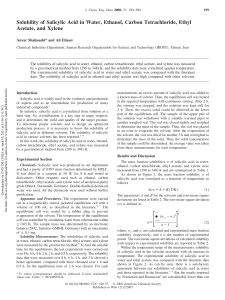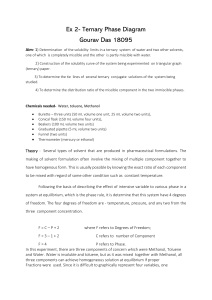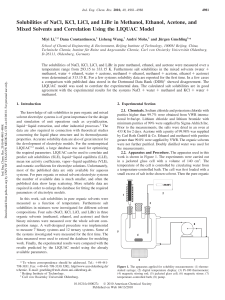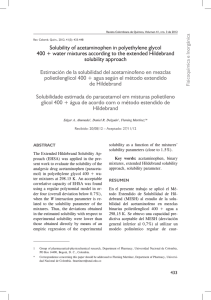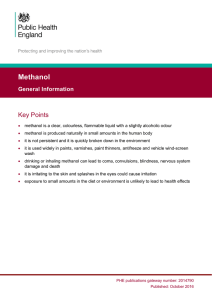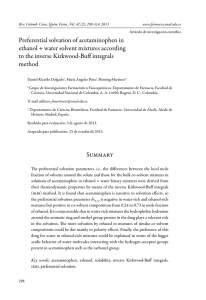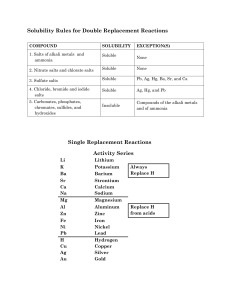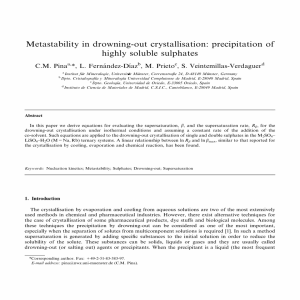Determination of mangiferin solubility in solvents used in the
Anuncio
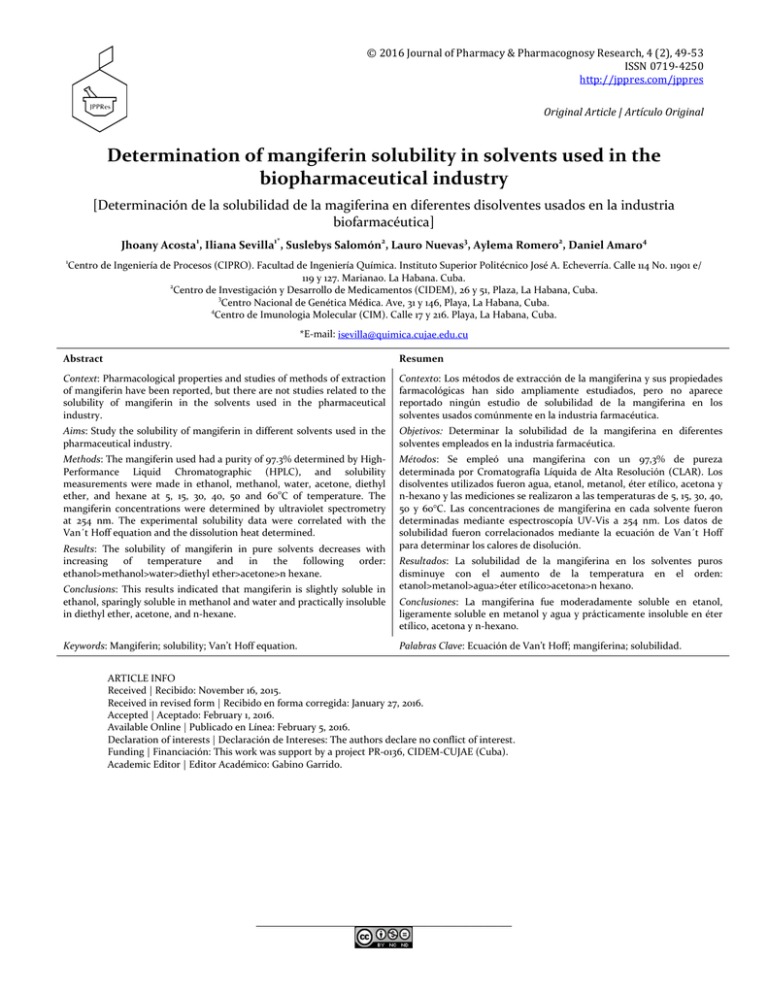
© 2016 Journal of Pharmacy & Pharmacognosy Research, 4 (2), 49-53 ISSN 0719-4250 http://jppres.com/jppres Original Article | Artículo Original Determination of mangiferin solubility in solvents used in the biopharmaceutical industry [Determinación de la solubilidad de la magiferina en diferentes disolventes usados en la industria biofarmacéutica] 1 1* 2 3 2 Jhoany Acosta , Iliana Sevilla , Suslebys Salomón , Lauro Nuevas , Aylema Romero , Daniel Amaro 4 1 Centro de Ingeniería de Procesos (CIPRO). Facultad de Ingeniería Química. Instituto Superior Politécnico José A. Echeverría. Calle 114 No. 11901 e/ 119 y 127. Marianao. La Habana. Cuba. 2 Centro de Investigación y Desarrollo de Medicamentos (CIDEM), 26 y 51, Plaza, La Habana, Cuba. 3 Centro Nacional de Genética Médica. Ave, 31 y 146, Playa, La Habana, Cuba. 4 Centro de Imunologia Molecular (CIM). Calle 17 y 216. Playa, La Habana, Cuba. *E-mail: [email protected] Abstract Resumen Context: Pharmacological properties and studies of methods of extraction of mangiferin have been reported, but there are not studies related to the solubility of mangiferin in the solvents used in the pharmaceutical industry. Contexto: Los métodos de extracción de la mangiferina y sus propiedades farmacológicas han sido ampliamente estudiados, pero no aparece reportado ningún estudio de solubilidad de la mangiferina en los solventes usados comúnmente en la industria farmacéutica. Aims: Study the solubility of mangiferin in different solvents used in the pharmaceutical industry. Objetivos: Determinar la solubilidad de la mangiferina en diferentes solventes empleados en la industria farmacéutica. Methods: The mangiferin used had a purity of 97.3% determined by HighPerformance Liquid Chromatographic (HPLC), and solubility measurements were made in ethanol, methanol, water, acetone, diethyl ether, and hexane at 5, 15, 30, 40, 50 and 600C of temperature. The mangiferin concentrations were determined by ultraviolet spectrometry at 254 nm. The experimental solubility data were correlated with the Van´t Hoff equation and the dissolution heat determined. Métodos: Se empleó una mangiferina con un 97,3% de pureza determinada por Cromatografía Líquida de Alta Resolución (CLAR). Los disolventes utilizados fueron agua, etanol, metanol, éter etílico, acetona y n-hexano y las mediciones se realizaron a las temperaturas de 5, 15, 30, 40, 50 y 60°C. Las concentraciones de mangiferina en cada solvente fueron determinadas mediante espectroscopía UV-Vis a 254 nm. Los datos de solubilidad fueron correlacionados mediante la ecuación de Van´t Hoff para determinar los calores de disolución. Results: The solubility of mangiferin in pure solvents decreases with increasing of temperature and in the following order: ethanol>methanol>water>diethyl ether>acetone>n hexane. Conclusions: This results indicated that mangiferin is slightly soluble in ethanol, sparingly soluble in methanol and water and practically insoluble in diethyl ether, acetone, and n-hexane. Keywords: Mangiferin; solubility; Van’t Hoff equation. Resultados: La solubilidad de la mangiferina en los solventes puros disminuye con el aumento de la temperatura en el orden: etanol>metanol>agua>éter etílico>acetona>n hexano. Conclusiones: La mangiferina fue moderadamente soluble en etanol, ligeramente soluble en metanol y agua y prácticamente insoluble en éter etílico, acetona y n-hexano. Palabras Clave: Ecuación de Van’t Hoff; mangiferina; solubilidad. ARTICLE INFO Received | Recibido: November 16, 2015. Received in revised form | Recibido en forma corregida: January 27, 2016. Accepted | Aceptado: February 1, 2016. Available Online | Publicado en Línea: February 5, 2016. Declaration of interests | Declaración de Intereses: The authors declare no conflict of interest. Funding | Financiación: This work was support by a project PR-0136, CIDEM-CUJAE (Cuba). Academic Editor | Editor Académico: Gabino Garrido. _____________________________________ Acosta et al. Mangiferin solubility studies INTRODUCTION Mangiferin (Fig. 1), is a xanthone widely distributed in higher plants such as Mangifera indica L. (Núñez et al., 2002) and Anemarrhena asphodeloides Bung (Chul et al., 2006), showing antidiabetic (Muruganandan et al., 2005), antitumor (Sarkar et al., 2004), antiviral (Zhu et al., 1993), antioxidant (Dar et al., 2005), immunomodulatory (Guha et al., 1996; Leiro et al., 2004a;b), and anti-inflammatory (Garrido et al., 2004; Prabhu et al., 2006) activities. CH2OH O H H OH OH H OH O H OH H OH OH O HO Figure 1. Molecular structure of mangiferin. A variety of pure solvents has usually been employed in a reaction and separation process during manufacturing of pharmaceuticals. Therefore, solubility data of bioactive compounds have a broad application and great importance in the pharmaceutical industry. It is very well known that the solubility behavior of drugs in solvent mixtures is very significant because solvents blends are frequently used in purification methods, pre-formulation studies, among other applications (Yalkowsky, 1999). For these reasons it is important to determine systematically the solubility of drugs to obtain complete information about physicochemical data for pharmaceutical systems. Otherwise, tempera- ture-solubility dependence allows perform the respective thermodynamic analysis, which, on the other hand, also allows inside the molecular mechanisms involved in the solution processes. The Dictionary of Natural Products and the Chemical Booklist show that the mangiferin is practically insoluble in diethyl ether, n-hexane, and water (DPN, 2005; CBL, 2014). However, according to a bibliographical search, there are no quantitative values of mangiferin in these solvents. A review of the literature indicates that studies on mangiferin have been focused on preparations or clinical treatments and patent of manufacture while little work has been carried out about the solubility of mangiferin. In the present work, we have measured the solubility of mangiferin in water and five organic compounds commonly used in the pharmaceutical industry in the range of 5 to 60°C of temperature. MATERIAL AND METHODS Materials Ethanol, methanol, diethyl ether, acetone, hexane were supplied as a chromatographic grade by Merck with purities exceeding 99.5% and they were used without previous purification. However, purities of the solvents were checked by gas chromatography. Deionized water was supplied from our laboratory. Experimental data of density and refractive index of solvents are given in Table 1 (Riddick, 1986). Table 1. Comparison of densities (ρ) and refractive indexes (ηD) of pure components with literature data at 30°C and atmospheric pressure. Solvents −3 nD ρ (g cm ) Boiling point 0 Literature* Experimental Literature* Experimental ( C) Methanol 1.3288 1.3300 0.7914 0.7953 64.6 Ethanol 1.3611 1.3614 0.7893 0.7902 78.5 Diethyl ether 1.3530 1.3532 0.7135 0.7125 34.5 Acetone 1.3588 1.3589 0.7899 0.7910 56.05 Hexane 1.3751 1.3751 0.6548 0.6551 69 Water 1.33250 1.3325 0.9970 0.9970 100 *Source: Durst and Gokel, 1985. http://jppres.com/jppres J Pharm Pharmacogn Res (2016) 4(2): 50 Acosta et al. Mangiferin solubility studies mangiferin. Each experiment was conducted in triplicate. Concentrations were determined by measuring absorbance after appropriate dilution and interpolation from previously constructed UV spectrophotometric calibration curve. Mangiferin (MGD13020) was purchased by CIDEM, and the purity was verified by HPLC (Shimadzu, Japan) to take account the method development in the literature (Salomón et al., 2014). The determined purity was 97.3 mass percent. Statistical analysis Apparatus and procedure Data were analyzed using the statistical program STATGRAPHICS PLUS Version 5.1 1994 – 2001. Intra- and inter-groups statistically significant differences were tested using one-way analysis of variance (ANOVA). The results are presented as mean ± standard deviation (SD). P-value < 0.05 was considered statistically significant. Solubility measurements were made at 5, 15, 30, 40, 50 and 60°C of temperature. Mangiferin decomposes at temperatures higher than 273°C. The mangiferin concentrations were determined by ultraviolet (254 nm) spectrometry with a UV spectrometer (Shimadzu, UV mini 1240, Japan). A mechanically stirred jacketed glass vessel (200 mL), equipped with a thermometer a reflux condenser with a CaCl2 tramp, and closed by a glass plug was used by the solubility studies. The temperature of the vessel was controlled by circulating thermostated water in the jacket, and it was maintained constant. The temperature was measured with an accuracy of ± 0.1°C. The content of the vessels was stirred at 250 rpm. The mass of mangiferin (about 1 g) was chosen to be in excess of the highest estimated solubility in the chosen solvents (about 150 mL. At each temperature, samples of supernatant (1 mL) were withdrawn from the stirred vessel after a long time (about 8 hours). A portion of the solution (10 mL) was taken and centrifuged at 2200 rpm for 20 min. Samples were filtered through a 0.45 µm (Sartorius, Switzerland) membrane to exclude solid RESULTS Solubility studies In all solvents studied solubility increase with the increase of temperature. Highest values of solubility of mangiferin were obtained with ethanol and methanol, and the smallest values were obtained using n-hexane (Table 2). ANOVA test indicates that there is a significance difference between ethanol and methanol with water, ether, acetone and n-hexane for the temperatures of 5 and 150C. In the case of 30 and 450C, hexane, acetone and ether are significantly different from water, methanol and ethanol and for the temperature of 600C all the solvents studied are significantly different. Table 2. Average values of mangiferin solubility in different solvents used in the pharmaceutical industry. 0 Temperature ( C) Solvents 5 15 30 45 60 Solubility (g of mangiferin per 100 g of solvent) a 0.7122 ± 0.2461 a 0.7005 ± 0.0525 Ethanol 0.5230 ± 0.6776 Methanol 0.4988 ± 0.0673 Water 0.1611 ± 0.0206 Diethyl ether 0.0022 ± 0.0004 Acetone n-Hexane b a 1.2516 ± 0.0469 a b c 0.0013 ± 0.0002 c 0.0003 ± 0.0002 a b 1.1454 ± 0.0472 c 0.2487 ± 0.0190 b 0.0015 ± 9.36E-05 b 0.0043 ± 0.0003 b d d 0.0016 ± 0.0002 0.0015 ± 0.0005 b d 2.5189 ± 0.0286 a b 1.1328 ± 0.0583 c 0.1958 ± 0.0373 0.0032 ± 0.0002 0.0012 ± 0.0006 2.3493 ± 0.2092 0.8880 ± 0.1102 0.1808 ± 0.0113 c a - 0.3931 ± 0.0165 c d - d 0.0038 ± 0.0006 0.0021 ± 0.0008 0.0017 ± 0.0005 d Data are presented as mean ± SD. Each group included five replicates. For each temperature same letters are no significant different according to an ANOVA test (p > 0.05) http://jppres.com/jppres J Pharm Pharmacogn Res (2016) 4(2): 51 Acosta et al. Mangiferin solubility studies Solubility correlation The solubility of mangiferin in methanol, acetone, ethanol, diethyl ether, n-hexane and water was correlated according to the Van΄ t Hoff equation (1). (1) Where CS is the solubility of mangiferin, T is the temperature and α, β are the correlations coefficients. According to Van’t Hoff analysis, the standards heat of solution is obtained from the slope of ln Cs vs. 1/T plot according to equation (2). (2) Table 3 shows the values for the parameters α and β and the correlations coefficients. In all cases the standards heat of solution are positive, that means there is an endothermic process, having the major value absorbed with n-hexane and the small value with acetone. Table 3. Values for the Van’t Hoff parameters α and β and the correlation coefficients (r). Solvent α β R ΔH (kJ/mol) Ethanol 9.695 -2873 0.968 23.87 Methanol 4.232 -1341 0.936 11.14 Water 3.066 -1381 0.879 11.48 Diethyl ether 1.920 -2225 0.974 18.49 Acetone -3.126 -980 0.930 8.14 n-Hexane 4.956 -3515 0.837 29.21 DISCUSSION The solubility of mangiferin increased with an increased in the temperature in each solvent. This result is correct due to when the temperature increased to improve the process of dissolution of solute and the solubility increased. http://jppres.com/jppres Polar molecule dissolves easily in a polar solvent, which is the so-called empirical rule that “like dissolves like”. During dissolution, the cohesive energy of the bonds holding solute together and the energy cost of disrupting the solvent-solvent bonds must be overcome by the cohesive energy released by the formation of the solute-solvent bonds. If these energies are approximately equal, which occurs when the solute and the solvent molecular are structurally similar, then the solute will dissolve in the solvent. The molecular structure of the title compound (see Fig. 1) shows that mangiferin is a molecule with intermediate polarity; hence, it can be dissolved in ethanol. However, a report explains that mangiferin obtained from Cyclopia subternata is more soluble in acetonitrile, methanol, and ethanol by this order (Maicu, 2008). Other authors comment that the presence of water facility the extraction of phenolic compounds due to the increased of solubility for the variety of polarity and the chemical nature of this metabolite (Bergeron et al., 2005). Furthermore, mangiferin is slightly soluble in ethanol, sparingly soluble in methanol and water and practically insoluble in diethyl ether, acetone, and n-hexane. Hence, diethyl ether, acetone, and n-hexane can be used as an antisolvent. In general, linear regression models with a high adjusted determination coefficient values (R2) were obtained (greater than 0.80). For this reason, it is considered that the Van’t Hoff equation is useful for estimating the enthalpies of the solution in all solvents. CONCLUSIONS The solubility of mangiferin was determined experimentally in ethanol, methanol, water, diethyl ether, acetone, and n-hexane at different temperatures. For all cases was observed that increased the solubility of mangiferin respect to increasing of temperature. Mangiferin was slightly soluble in ethanol, sparingly soluble in methanol and water and practically insoluble in diethyl ether, acetone, and n-hexane. The experimental solubility data were correlated with a Van΄t Hoff equation and the standards heat of solution for the different solvents was calculated J Pharm Pharmacogn Res (2016) 4(2): 52 Acosta et al. for the first time, obtaining a major heat absorbed with n-hexane. CONFLICT OF INTEREST The authors declare no conflict of interest. ACKNOWLEDGEMENT This work was support by a project PR-0136, CIDEMCUJAE (Cuba). REFERENCES Bergeron C, Gafner S, Clausen E, Carrier DJ (2005) Comparison of the chemical composition of extracts from Scutellaria lateriflorausing accelerated solvent extraction and supercritical fluid extraction versus standard hot water or 70% ethanol extraction. J Agric Food Chem 53: 3076-3080. CBL: Chemical Book List (2014). http://www.chemicalbook.com/ChemicalProductProperty _EN_CB8723435.htm [Consulted March 16, 2014]. Chul K, Mi-Jeong A, Jinwoong K (2006) Preparative isolation of mangiferin from Anemarrhena asphodeloides rhizomes by centrifugal partition chromatography. J Liq Chromatogr Relat Technol 29: 869–875. Dar A, Faizi S, Naqvi S, Roome T, Zikr-ur-Rehman S, Ali M, Firdous S, Moin ST (2005) Analgesic and antioxidant activity of mangiferin and its derivatives: the structure activity relationship. Biol Pharm Bull 28(4): 596-600. DPN: Dictionary of Natural Products on CD-ROM (2005) Chapman & Hall/CRC. Chemical Database ver. 13:2. London, UK. Durst HD, Gokel GW (1985) Química orgánica experimental. Ed. Reverte, pp. 122-126. Garrido G, Delgado R, Lemus Y, Rodriguez J, Garcia D, Nunez AJ (2004) Protection against septic shock and suppression of tumor necrosis factor alpha and nitric oxide production on macrophages and microglia by a standard aqueous extract of Mangifera indica L. (VIMANG). Role of mangiferin isolated from the extract. Pharmacol Res 50: 165-172. Guha S, Ghosal S, Chattopadhyay U (1996) Antitumor, immunomodulatory and anti-HIV effect of mangiferin, a Mangiferin solubility studies naturally occurring glucosylxanthone. Chemotherapy 42: 443–451. Leiro J, Arranz JA, Yanez M, Ubeira FM, Sanmartin ML, Orallo F (2004a) Expression profiles of genes involved in the mouse nuclear factor-kappa B signal transduction pathway are modulated by mangiferin. Int Immunopharmacol 4: 763-778. Leiro J, Garcia D, Arranz JA, Delgado R, Sanmartin ML, Orallo F (2004b) An Anacardiaceae preparation reduces the expression of inflammation-related genes in murine macrophages. Int Immunopharmacol 4: 991-1003. Maicu MC (2008) Optimization of retention of mangiferin in Cyclopia subternata during preparation for drying and storage of green honeybush and development of NIR spectroscopy calibration models for rapid quantification of mangiferina and xhantone contents. Master Thesis. University of Stellenbosh. Muruganandan S, Srinivasan K, Gupta S, Gupta PK, Lal J (2005) Effect of mangiferin on hyperglycemia and atherogenicity in streptozotocin diabetic rats. J Ethnopharmacol 97: 497-501. Núñez AJ, Velez HT, Agüero J, Gonzalez J, Naddeo F, De Simone F, Rastrelli L (2002) Isolation and quantitative analysis of phenolic antioxidants, free sugars, and polyols from mango (Mangifera indica L.) stem bark aqueous decoction used in Cuba as a nutritional supplement. J Agric Food Chem 50(4): 762-766. Prabhu S, Jainu M, Sabitha KE, Shyamala CS (2006) Effect of mangiferin on mitochondrial energy production in experimentally induced myocardial infarcted rats. Vascul Pharmacol 44: 519–525. Riddick JA, Bunger WB, Sakano T (1986) Organic Solvents. John Wiley: New York. pp. 74, 92–93, 336–337. Salomón S, Sevilla I, Betancourt R, Romero A, Nuevas L, Acosta J (2014) Extraction of mangiferin from Mangifera indica L. leaves using microwave assisted technique. Emir J Food Agric 26: 616-622. Sarkar A, Sreenivasan Y, Ramesh GT, Manna SK (2004) betaD-Glucoside suppresses tumor necrosis factor-induced activation of nuclear transcription factor kappaB but potentiates apoptosis. J Biol Chem 279: 33768-33781. Yalkowsky SH (1999) Solubility and Solubilization in Aqueous Media. American Chemical Society and Oxford University Press: New York, pp. 180–235. Zhu XM, Song JX, Huang ZZ, Wu YM, Yu MJ (1993) Antiviral activity of mangiferin against herpes simplex virus type 2 in vitro. Zhongguo Yao Li Xue Bao 14: 452-454. _________________________________________________________________________________________________________________ http://jppres.com/jppres J Pharm Pharmacogn Res (2016) 4(2): 53

